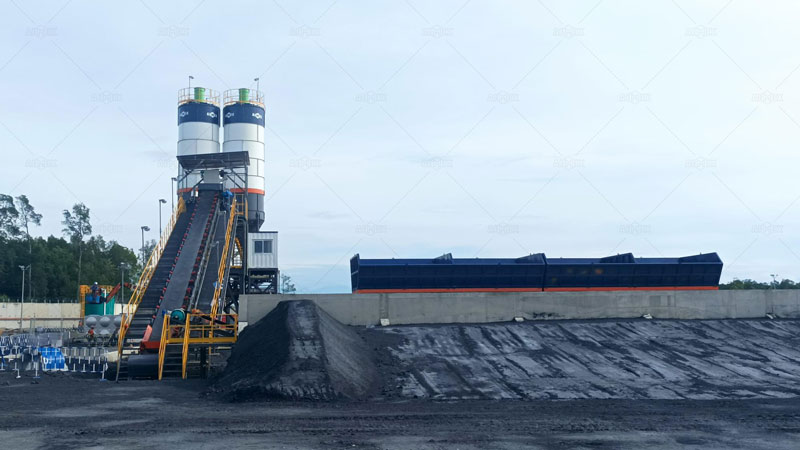The global construction industry is increasingly affected by fluctuations in the cost of raw materials—especially steel. As one of the most critical components in the manufacturing of concrete batching plants, steel directly influences the overall concrete plant price. For businesses evaluating investment in a mobile concrete plant or a full-scale ready mix concrete plant, understanding how steel prices affect total costs is essential to avoid surprises and manage budgets wisely.
Why Steel Matters in Concrete Plant Construction
Steel forms the structural backbone of any concrete plant. The frames, support structures, mixer chassis, silos, hoppers, and even the control cabins are fabricated using varying grades and thicknesses of steel. Depending on the model and configuration, steel typically comprises 30% to 65% of the total raw material cost of the equipment.
In particular, mobile concrete plants, which must be durable yet portable, rely heavily on reinforced steel frames and wheeled structures. Stationary plants, often used for large infrastructure projects, require even more steel due to their size, modular complexity, and foundation systems. The heavier the plant, the more steel it uses—and the more sensitive it becomes to steel market trends.
How Do Rising Steel Prices Affect Concrete Plant Price?
When steel prices increase, manufacturers must either absorb the cost—which reduces profit margins—or pass the extra cost onto buyers, raising the final concrete plant price(planta de concreto precio). In most cases, price adjustments are inevitable. In fact, for every 10% rise in steel prices, the average price of a concrete plant could rise by 3–6%, depending on plant size and steel content.
Consider a mid-sized ready mix concrete plant that requires 60 tons of structural and reinforcing steel. A $150 per ton increase in steel prices would raise the production cost by $9,000. This doesn’t even include the cascading effect on welding, fabrication, transportation, and installation costs, all of which are impacted by steel market volatility.

Case in Point: Recent Price Volatility
From 2020 to 2023, global steel prices rose dramatically—at some points exceeding $1,000 per metric ton for hot-rolled coil. Factors driving this volatility include pandemic-related supply chain disruptions, rising energy costs, geopolitical tensions, and increased demand from emerging economies. Even though prices have cooled somewhat in 2024–2025, they remain well above historical averages.
For example, in Latin America, many projects have reported cost overruns due to rising equipment prices linked directly to steel. This has particularly affected buyers of ready mix concrete plants for infrastructure and commercial construction projects, where large-scale units are needed.
Impact on Different Concrete Plant Types
Not all concrete plants are affected equally by steel price fluctuations. Let’s break down the differences:
- Mobile Concrete Plant: Though smaller in scale, mobile plants(planta de hormigon movil) use a higher proportion of high-strength steel to ensure stability during transportation and rapid assembly. Steel price increases significantly affect the base frame and trailer unit cost.
- Stationary Concrete Plant: These plants are more steel-intensive due to their long-term design, including larger silos, mixing platforms, and heavy-duty supports. A significant steel price hike can increase their base price by tens of thousands of dollars.
- Compact or Modular Plants: While designed for easier transport and setup, modular units often require custom-fabricated steel frames, which can also become expensive when steel costs surge.

Exchange Rates and Regional Disparities
In markets like Southeast Asia, Africa, and Latin America, the impact of steel price increases is often compounded by unfavorable exchange rates. Since most high-quality steel and some concrete plant(planta de concreto) components are imported, buyers in these regions often face dual pressures: global commodity inflation and local currency depreciation.
For example, a plant priced in USD becomes significantly more expensive for buyers using local currencies like the Colombian peso or the Argentine peso during times of currency weakness. This makes forward planning and price locking even more critical.
How Manufacturers and Buyers Are Responding
1. Early Procurement & Strategic Stockpiling
Manufacturers with the capacity to purchase steel in bulk when prices are low can better control equipment costs. Some even stockpile critical components in advance to avoid price shocks during order fulfillment.
2. Design and Engineering Optimization
To mitigate the need for high volumes of steel, many manufacturers are shifting toward smarter, lighter designs that maintain durability while reducing steel usage. Modularization and prefabrication also help limit waste.
3. Price Lock-in and Forward Contracts
Buyers are increasingly requesting fixed-price quotes with longer validity periods to guard against steel-driven inflation. Some opt for turnkey deals where the manufacturer takes on the raw material risk, though this typically comes at a premium.
4. Consideration of Alternative Materials
Although steel is irreplaceable in many structural elements, there is growing interest in exploring aluminum, high-strength polymers, or reinforced composites for certain non-structural parts, where feasible.
Conclusion: Steel Prices Are a Key Cost Driver
The link between steel prices and concrete plant price is direct and significant. Rising steel costs influence every aspect of the plant—from its raw material sourcing and design, to production and delivery. For buyers planning to purchase a mobile concrete plant or a ready mix concrete plant(planta de concreto premezclado), keeping a close eye on steel market trends is not optional—it’s strategic.
In today’s volatile economic environment, price transparency, early planning, and supplier collaboration are essential to minimize risk and maximize long-term value from your concrete equipment investment.
